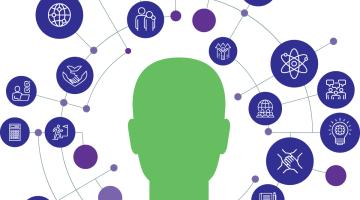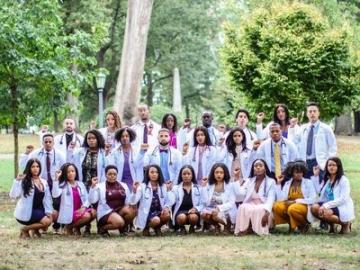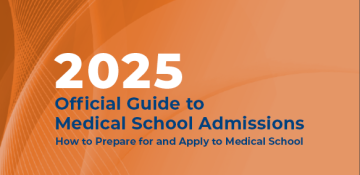New section
"Throughout the application process, I was worried that schools would automatically eliminate my application from consideration due to my undergraduate GPA. I was told that to most schools, applicants are merely a number and a GPA below 'x' would automatically throw someone out of the running for acceptance. These worries were unfounded, and I ended up landing several interviews and multiple acceptances."
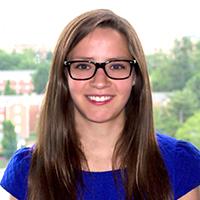
Med School: University of Texas Southwestern, 2021.
Graduate: Johns Hopkins University's Bloomberg School of Public Health.
Undergrad: Johns Hopkins University.
Editor’s Note: The opinions expressed in this article are those of the author and do not necessarily reflect the opinions, positions, or the polices of the AAMC or its members.
New section
Background
- Suffered from spinal disc injuries.
- Had initial challenges with health care providers during the first stages of her treatment.
- Interest in science led to clinical and laboratory research at an early age.
- Mentor’s demonstration of holistic, compassionate patient care provided a role model and cemented her decision to seek a career in medicine.
- Late start to pursuing medicine, resulted in her catching up on prerequisites and completing a master’s program.
Academics
Erin began setting up appointments with her pre-health advisor, Dr. David Verrier, during the fall of her senior year. He had some concerns about her GPA and performance in premedical requirements, so he helped Erin carefully review her study strategies and devise a plan for postbaccalaureate studies.
There were other extenuating circumstances that impacted her performance in summer coursework that could only be fully appreciated by a very careful and open-minded person reading her application.
After graduation, she took a year off to give herself adequate time to resolve these obstacles that had impeded her academic performance. Thanks to her determination and diligence, Erin went on to graduate from JHU’s Bloomberg School of Public Health with a perfect 4.0 graduate GPA and, as a result, left no doubt about her abilities to handle the rigors of science in medical school.
Experiences
Because of her father’s family and background, Erin has always been aware of the public health obstacles faced by Native American populations. As co-president of Native Circle (a group comprised of Hopkins students, staff, faculty and community members who are dedicated to the advancement of Native American populations), she fought to raise awareness of these issues on campus and raise funds to support public health projects that improve the health, education, and well-being of Native Americans. Following graduation, she stepped up her commitment to Native American health by performing public health research amongst indigenous and medically underserved populations as a faculty member at the Johns Hopkins Bloomberg School of Public Health Center for American Indian Health.
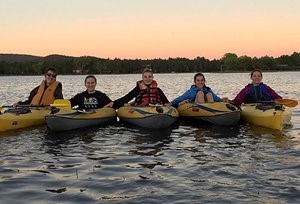
Personal Statement
Erin saw her personal statement as an opportunity to tell her story and answer the question “Why medicine?” She said, “The most difficult aspect of this was sifting through a lifetime of experiences and deciding which were most relevant in this story. It took months of reflection to do this and then express this in words.” Erin said that her personal statement was a good place to tell her story for two reasons. First, it gave her an opportunity to explain the obstacles she faced in college that affected her academic performance. Secondly, it allowed her to express her determination to achieve a career in medicine.
Erin presented an early draft of her personal statement to her prehealth advisor, Dr. Verrier, during her last semester of graduate school. He helped her sort out elements of her story that would be important for the admissions committee to hear. “I had worked extremely hard in graduate school to make a 4.0 and also published some more research. He helped me to emphasize strengths in my application and helped me with my personal statement.” Aside from this, Erin did not have others review her personal statement because she wanted it to reflect who she was using her own words, and she worried that having others edit and revise could drown out her own voice.
Letters of Evaluation
Erin thinks that her application stood out because of her graduate-level academic work and work experience in ophthalmology and public health; having strong letters of recommendation was also a key factor.
“In my journey, I was lucky to stumble upon mentors who selflessly invested time and energy in me.” One of these mentors was Erin’s neuroscience professor, Dr. Stewart Hendry. Erin entered college set on becoming a neuroscientist, and Dr. Hendry embodied who she aspired to become: a brilliant scientist, effective teacher, and a good person. Erin realized in her early college years that she didn’t know how to study, and Dr. Hendry’s courses were notorious for being difficult — an attribute that steered many premeds away. Erin barely earned a C in the first class, but she regularly attended office hours and used his advice to improve as a student. She says, “I know that I would not be where I am today without his help and patience. My last semester I took his Visual Systems course, which was deemed to be the most difficult of his courses. In my last semester I had finally improved as a student such that I was able to earn an A+.” Having taken over 8 courses by Dr. Hendry, Erin knew that he understood her development as a student and would be able to speak to her strengths.
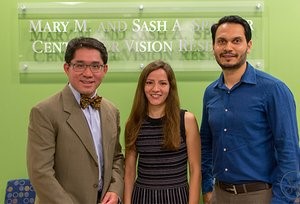
Other mentors that Erin asked for a letter of recommendation included Dr. Quan Dong Nguyen and Dr. Yasir Sepah. By her sophomore year of college, Erin had grown tired of the technical nature of laboratory work, but she still had to fulfill research credits for her major. Through some chance encounters, she met Sepah and ended up working with Sepah and Nguyen in clinical ophthalmology research. Through her interactions with them she began to appreciate the higher level conceptual framework of clinical research. Ngyuen and Sepah continuously challenged her by giving her more responsibilities and they were always available to provide guidance. Because of them, Erin decided to pursue ophthalmology as a career but learned that she needed to become a physician in order to do so. They were extremely proud that she had come to this decision and were happy to help her in any way possible.
Another person that kindly wrote a letter of recommendation for Erin was her master’s thesis advisor, Dr. Valerie Culotta, a very successful and inspiring scientist. While Dr. Culotta did not know Erin as long as some of the other letter writers, she was there for the entire process of her thesis, and Erin had taken one of her courses in graduate school. Through the thesis process and in her course, she had come to know Erin well, and Erin knew she could speak to her work ethic.
Erin says, “I think the letters of evaluation must have been a good complement to the personal statement that spoke to my personal characteristics from the perspective of others who knew me well.”
Interview
Erin said that the part of the application process she was most confident about was the interview. “I had a lot of work experience and was therefore very comfortable with speaking with people and speaking in front of audiences. I also love talking with people and getting to know people in general. Because of this, the interview just felt like any other conversation.”
When asked how she prepared for her medical school interview, Erin said, “I felt that the past few years had essentially been a preparation for the interview.” She asked friends for advice on what to wear, and she booked a flight for the day before the interview so that she could get a good night’s sleep the night before.
In her interviews, Erin was brutally honest about the weaknesses in her application. She was honest as to why her grades were low, including the life struggles she went through during college and not knowing how to study. Erin completed a master’s program to make up for her undergraduate GPA, and she did her best to assure interviewers that her grades in graduate school were more representative of her abilities, and that she had continued to keep up this caliber of work in medical school.
"It seems that a lot of students go straight from undergraduate studies to medical school or take a single year off in between. Accordingly, many of the interview questions seemed to be geared to this demographic and centered around things like college extracurricular activities and volunteering. In my instance, by the time I was interviewing, I had taken multiple years off and had a lot of work experience. I felt that there could have been more interview questions that asked about work experience.
When I accepted a job with JHSPH studying infectious disease and environmental health on Native American reservations, I had no idea that my job description would include everything from inspecting woodstoves in family homes on reservations, to presenting at conferences, to writing grants and doing statistics, to representing Hopkins in meetings with tribal leaders. I was constantly out of my comfort zone which forced me to grow, improve, and learn new skills. From my work, I developed a deep understanding of the many social and environmental determinants of health and their broad applications to health care.” All of this provided Erin with numerous interesting things to talk about in her interviews.
Postbacc Work
After graduating college, Erin realized she needed additional schooling to improve her grades. Her premed advisor, David Verrier, recommended a master’s program at Johns Hopkins Bloomberg School of Public Health (JHBSPH). Her advisor helped Erin come up with a workable, realistic, postgraduate plan to address the weaknesses in her academic record. “Having worked with many applicants who were able to offset weak undergraduate science records with stellar performance in postbaccalaureate or graduate-level sciences, I was very confident in Erin given her motivation, perseverance, resilience and adaptability, and capacity for improvement.”
Regarding the master’s program, Erin said, “If I was bummed about this initially, it was only because I didn’t understand the value this would have in my career and in preparing for my future. The program expanded my knowledge in biological sciences, trained me to excel in a fast-paced learning atmosphere, and also propelled me into the field of public health.”
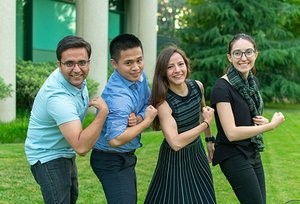
At JHBSPH, Erin had the unique experience of learning about biochemistry and molecular biology from a public health perspective. Her program covered topics like cell biology, molecular biology, immunology, and genetics in great detail. Erin learned to think critically to consider how both science and decisions at the level of individual patients can have broader implications in health care as a whole. Courses in epidemiology, granted her skills in statistics and statistical programming that are vital to research and understanding medicine at the population level. Erin hopes that her public health background will allow her to impact health care beyond the individual patient to create healthier communities.
Erin said, “The challenging nature of the material was not new to me, but in graduate school, material that was usually covered over the span of a semester was crammed into six weeks. At any given time, I was preparing for multiple tests, writing multiple papers, and working on group projects. Exceling in the program required juggling multiple academic and personal responsibilities. To this end I became the master of scheduling and absorbing heaps of material in a short amount of time.” Erin believes that her experience in a challenging science graduate program prepared her for a rigorous and fast-paced medical school curriculum.
Erin on Why She Chose the University of Texas Southwestern
“University of Texas Southwestern (UTSW) was one of my state schools. In order to remain interested, I knew that I needed an academic environment that would continuously challenge me. I knew that UTSW had a reputation of having a challenging curriculum and for graduating talented physicians.”
University of Texas Southwestern on Why They Chose Erin
“The UT Southwestern Admissions Committee seeks to identify the most academically qualified applicants who, in the judgment of the committee, will make the best physicians. They evaluate candidates in a holistic manner and are interested in identifying applicants who possess not only the academic capabilities but also the personal attributes and characteristics inherent in excellent and humanistic physicians.
Ms. Vigil graduated with a bachelor of science in neuroscience and subsequently a master of health science degree from the Bloomberg School of Public Health with a 4.0 cumulative GPA, demonstrating competency in the sciences. She coordinated research projects while at Johns Hopkins which culminated in presentation at a national meeting while serving as a clinical research fellow at the Wilmer Eye Institute, the only undergraduate in the group. These complex research activities in multiple team-oriented environments, demonstrated her critical thinking and quantitative reasoning skills, focus on scientific inquiry, and ability to communicate both in writing and orally. In addition to these significant accomplishments, Ms. Vigil financially supported herself through college, showing great resilience and adaptability, and reliability and dependability.
Additionally, the committee assesses the candidate’s motivation to pursue a career in medicine, ensuring alignment with [the] mission of the UT Southwestern Medical School which emphasizes the importance of training primary care physicians, educating doctors who will practice in medically underserved areas of Texas, and preparing physician-scientists who seek careers in academic medicine and research.”
New section
Highlighted Competencies
Note: This section helps to illustrate how multiple competencies can be demonstrated across many experiences, activities, and parts of your application.
Shows a commitment to something larger than oneself; demonstrates dedication to service and a commitment to making meaningful contributions that meet the needs of communities.
Participated in community work and research experience among indigenous populations.
Built strong relationships with faculty and research mentors; field experience among indigenous populations.
Appreciates how historical, sociocultural, political, and economic factors affect others’ interactions, behaviors, and well-being; values diversity; and demonstrates a desire to learn about different cultures, beliefs, and values.
Lived experiences; co-president of the Native Circle; conducted research among indigenous populations.
Effectively conveys information to others using spoken words and sentences; actively listens to understand the meaning and intent behind what others say; and recognizes potential communication barriers and adjusts approach or clarifies information as needed.
Conference presentations; meetings with tribal leaders.
Distance traveled; overcame health challenges; overcame early academic challenges and uncertainty in how to study effectively.
Practices continuous personal and professional growth for improvement, including setting and communicating goals for learning and development; reflects on successes, challenges, and mistakes; pursues opportunities to improve knowledge and understanding; and asks for and incorporates feedback to learn and grow.
Proactively sought and implemented guidance from faculty members and other mentors; consistently challenged herself with her coursework and research experience; demonstrated steady academic improvement, including significantly improving her study skills.
Demonstrates accountability for performance and responsibilities to self and others; prioritizes and fulfills obligations in a timely and satisfactory manner; and understands consequences of not fulfilling one’s responsibilities to self and others.
Balanced multiple academic and personal responsibilities.
Uses logic and reasoning to identify the strengths and weaknesses of alternative solutions, conclusions, or approaches to problems.
Extensive lab and field research experience; coursework in public and population health.
Effectively conveys information to others by using written words and sentences.
Demonstrated ability to write clearly about complex research, grant writing.
Applies quantitative reasoning and appropriate mathematics to describe or explain phenomena in the natural world.
Took courses with statistics and complex research activities.
Applies knowledge of the scientific process to integrate and synthesize information, solve problems, and formulate research questions and hypotheses; is facile in the language of the sciences and uses it to participate in the discourse of science and explain how scientific knowledge is discovered and validated.
Participated in multiple research projects including public health, clinical ophthalmology; research fellow at Wilmer Eye Institute.
